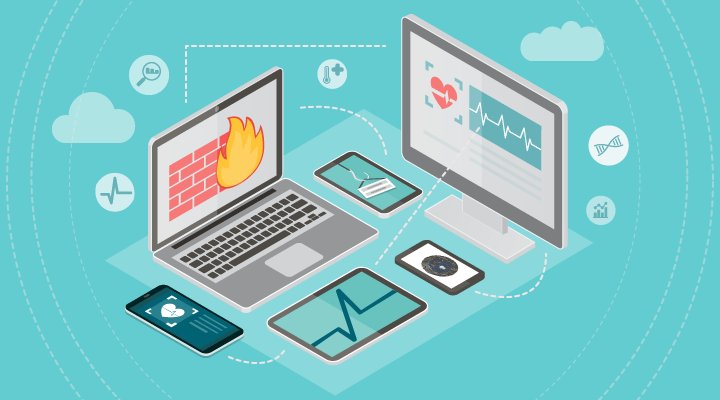6 Ways Privacy and Security Work Together to Improve Patient Care

With data breaches continuing to expose millions of people’s sensitive data every year, it’s natural that healthcare organizations and their customers are concerned. When the security of PHI is at stake, it’s essential to know what to do to keep this information safe with privacy and security measures. Protecting patient privacy and data security is, after all, essential to growing trust and providing excellent patient care.
While privacy and security are often intertwined at healthcare organizations, there are factors that differentiate the two. According to the Department of Health and Human Services, “privacy addresses the use and disclosure of individuals’ health information” and security “establish[es] a national set of security standards for protecting certain health information that is held or transferred in electronic form.” In short, privacy refers to a patient’s health information while security has to do with the technology that is used to keep their data confidential. But while they are distinct, the two must – and often do — work hand-in-hand to improve patient care.
Here are six ways privacy and security work together to improve patient care.
1. Keeping data safe from cybersecurity attacks
If a patient doesn’t believe their PHI is protected at a facility, they may be less than forthcoming with their care providers, or even choose a different facility altogether. The task of keeping personal health information (PHI) and personally identifiable information (PII) safe from hacking and security threats is table stakes in the healthcare world. And that task is becoming even more difficult, with hackers both domestically and globally working tirelessly to obtain sensitive data in any way they can, including through phishing emails. By implementing security measures and maintaining internal training, facilities are less likely to fall for email phishing attempts, social engineering, and other advanced threats to patient privacy.
But external attackers aren’t the only threat to PHI privacy: According to the Verizon Threat Research Advisory Center’s Insider Threat Report, the healthcare industry is the most hard-hit by insider threats, with internal personnel being responsible for a higher percentage of breaches than external actors. Healthcare organizations can prevent breaches and maintain patient privacy by putting security safeguards in place — such as ensuring that only those with a need-to-know can access PHI and that ex-employees are deprovisioned.
This way, patients’ most sensitive data remains protected from breaches, improving patient care by elevating their level of trust in knowing that their information is safe.
2. Minimizing loss from data breaches
Each year, data breaches compromise the sensitive data of millions of patients. In 2018, the amount of healthcare record breaches doubled since the previous year – from roughly five million breaches in 2017 to over 13 million in 2018. If you’re not already worried about how breaches can affect your facility, you should be. But the bright side of awareness is that the more prepared you are, the less costly a breach will be.
The alternative is costly – United States organizations had the highest cost of a breach, averaging about $7.91 million per record breached. Of all industries, the healthcare industry suffered the highest breach costs by far in 2018 at $408 per record, far exceeding the average cost of other industries.
3. GDPR-readiness
Although the regulation was passed in the EU, United States organizations must be compliant if they are handling the PII of EU residents. GDPR applies to every organization that processes the personal information of EU citizens — which is especially relevant for U.S. care providers that treat patients visiting from the EU.
Just like HIPAA, the cornerstone of GDPR is maintaining data privacy by ensuring that people are in control of their own personal information. Facilities that adhere to GDPR, or focus on security frameworks, will have a much stronger culture of security and privacy overall.
4. Greater transparency for patients
Thanks to years of HIPAA notices and recent high-profile privacy snafus at corporate giants like Facebook and Google – not to mention the near-daily press mentions of healthcare privacy breaches — patients are more aware of their rights than ever, and taking a more active role in asking how their data is being handled. Interoperability – the process of exchanging healthcare information – has played a significant role in giving patients more control over their PHI. But it’s also introduced privacy and security concerns, making it essential for both sides of the house to come together to find ways to enable interoperability without violating privacy.
5. Increasing patient satisfaction
Along with data transparency, patients have taken a more active role in both knowing and asking about how their information is stored, transferred, used, shared, and destroyed. Armed with that knowledge, they’re able to have greater control over their most sensitive data and a better understanding of the security measures that are put into place to keep that information private, leading to a greater level of satisfaction.
“Privacy is such a vital ingredient to organizational success, both to protect data and foster innovation.” John N. Stewart, Senior Vice President and Chief Security and Trust Officer,
6. Gaining competitive advantage
The more an organization invests in combatting privacy and security challenges, the more competitive advantages they’ll come to enjoy. Organizations that had prepared ahead of time through adherence to security frameworks like NIST, ISO 27001, and compliance with regulations like HIPAA and GDPR experienced fewer breaches. Among those organizations that were breached, those who had put security measures in place and maintained HIPAA compliance paid less on average as well.
There are many advantages to putting security in place to meet and maintain compliance with regulations like HIPAA, NIST, and GDPR. Keeping data safe from hacks and other threats while remaining transparent and compliant not only galvanizes your organization, but it also increases patient satisfaction by nurturing a sense of trust in knowing their important data is protected.
